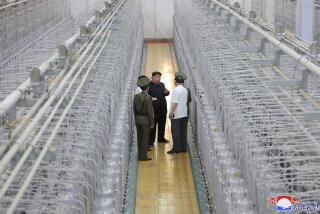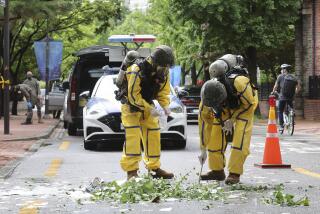North Korea vows to restart shuttered nuclear facilities
SEOUL -- North Korea announced Tuesday that it would restart nuclear facilities that were closed as part of a 2007 international disarmament agreement. The move comes at the urging of the communist state’s leader, Kim Jong Un, for the country to build up its economy and develop its nuclear program.
North Korean state media KCNA reported that the move was to make “a positive contribution” to solve the country’s acute electricity shortage and to bolster its “nuclear armed force” in quality and quantity.
The announcement comes after a rare plenary meeting of the central committee of the ruling Workers’ Party, which set a new strategic direction for the nation. At the meeting, Kim described the nuclear weapons program as the “nation’s life” and “treasure,” which “can never be abandoned.”
A spokesman for the General Department of Atomic Energy said North Korea “decided to adjust and alter the uses of the existing nuclear facilities,” including restarting a uranium enrichment plant and 5-megawatt graphite moderate reactor at Yongbyon, state media reported. The plant was disabled in October 2007 as part of a disarmament deal reached in six-party talks that included North Korea, the U.S., China, South Korea, Japan and Russia.
South Korea’s Foreign Ministry expressed “deep regrets” over North Korea’s announcement and urged the nation “to fully abide by agreements reached to ensure denuclearization of the Korean peninsula.”
According to KCNA, the restart of Yongbyon operations will begin immediately.
“North Korea is putting into practice what they have said previously, that they would strengthen the economy and nuclear program,” said Dr. Park Syung-je, an analyst with the Seoul-based Asia Strategy Institute. “North Korea has led the rest of the world on with lies, saying that nuclear power generation is their top priority. However, with such an announcement, North Korea has proved that nuclear development was their actual priority.”
The Pyongyang regime has been widely condemned for its nuclear ambitions.
After conducting a banned nuclear test in February, the communist state was slapped with strict United Nations sanctions, which were approved by the U.S. and the North’s closet ally, China. In response, Kim’s regime began ratcheting up the aggressiveness of its rhetoric.
Pyongyang has issued a number of stark threats in recent days, including stating that the two Koreas were now “in a state of war,” and vowing nuclear strikes on the United States.
After the “state of war” declaration over the weekend, the White House said no major troop movements were detected in North Korea. White House officials have said the Pyongyang regime has shown no “action to back up the rhetoric.”
The Navy, however, is moving a sea-based radar platform closer to North Korea to track possible missile launches, a Pentagon official said Monday. The move is the latest step to deter the North and reassure South Korea and Japan that the U.S. is committed to their defense.
Also on Tuesday, top envoys to six-party talks, South Korea’s Lim Sung-nam and U.S. Special Representative for North Korea Policy Glyn Davies, met in Washington to discuss the tension on the Korean peninsula.
ALSO:
March bloodiest month so far in Syria uprising
Hamas reelects Meshaal as leader, official says
North Korea, in break from bluster, elevates reformer
More to Read
Sign up for Essential California
The most important California stories and recommendations in your inbox every morning.
You may occasionally receive promotional content from the Los Angeles Times.










